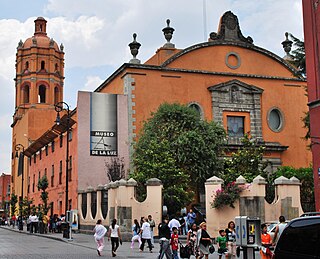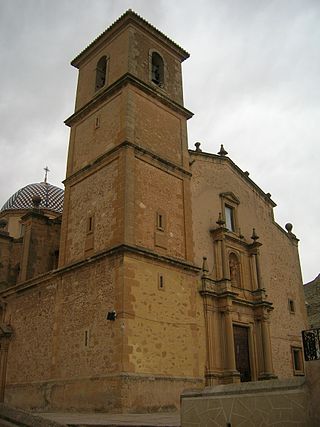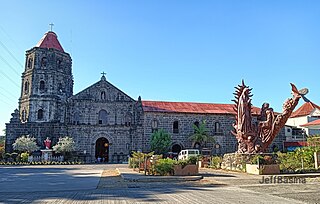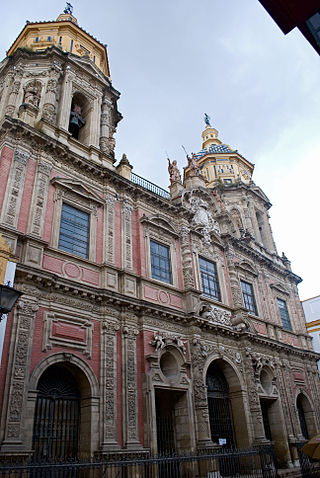
Baroque architecture is a highly decorative and theatrical style which appeared in Italy in the early 17th century and gradually spread across Europe. It was originally introduced by the Catholic Church, particularly by the Jesuits, as a means to combat the Reformation and the Protestant church with a new architecture that inspired surprise and awe. It reached its peak in the High Baroque (1625–1675), when it was used in churches and palaces in Italy, Spain, Portugal, France, Bavaria and Austria. In the Late Baroque period (1675–1750), it reached as far as Russia, the Ottoman Empire and the Spanish and Portuguese colonies in Latin America. In about 1730, an even more elaborately decorative variant called Rococo appeared and flourished in Central Europe.

Arcos de la Frontera is a town and municipality in the Sierra de Cádiz comarca, province of Cádiz, in Andalusia, Spain. It is located on the northern, western and southern banks of the Guadalete river, which flows around three sides of the city under towering vertical cliffs, to Jerez and on to the Bay of Cádiz. The town commands a fine vista atop a sandstone ridge, from which the peak of San Cristóbal and the Guadalete Valley can be seen. The town gained its name by being the frontier of Spain's 13th-century battle with the Moors.

The Royal Palace of La Granja de San Ildefonso, known as La Granja, is an early 18th-century palace in the small town of San Ildefonso, located in the hills near Segovia and 80 kilometres (50 mi) north of Madrid, within the Province of Segovia in central Spain.

Spanish Baroque is a strand of Baroque architecture that evolved in Spain, its provinces, and former colonies.

La Santísima Church is located 12 La Santísima Street at corner of Emiliano Zapata Street in the historic center of Mexico City. Its full name is Church and Hospital of the Most Holy Trinity. The church was built between 1755 and 1783 as a temple for the adjoining hospital/hospice for priests. The hospital functioned until 1859, when the Reform Laws nationalized much of Church's property in Mexico. The church still retains its original function but the adjoining hospital and office sites have since moved into private hands with only parts of the original structures still intact and preserved.

Colegio de San Ildefonso, currently is a museum and cultural center in Mexico City, considered to be the birthplace of the Mexican muralism movement. San Ildefonso began as a prestigious Jesuit boarding school, and after the Reform War it gained educational prestige again as National Preparatory School. This school and the building closed completely in 1978, then reopened as a museum and cultural center in 1992. The museum has permanent and temporary art and archeological exhibitions in addition to the many murals painted on its walls by José Clemente Orozco, Fernando Leal, Diego Rivera, and others. The complex is located between San Ildefonso Street and Justo Sierra Street in the historic center of Mexico City.

St. Isidore's Collegiate Church, or simply referred to as the Colegiata, is a Baroque Catholic church in central Madrid, Spain. It is named after and holds the relics of Saint Isidore, who is patron of Madrid, as well as his wife, Santa María de la Cabeza. It has held the status of a minor basilica for centuries.

The San Pedro y San Pablo College is a colonial church located in the historical center of Mexico City, Mexico.

The Church of San Felipe Neri, commonly known as "La Profesa", is a Roman Catholic parish church that was established by the Society of Jesus late in the 16th century as the church of a community of professed Jesuits. The church is considered to be an important transitional work between the more sober or moderate Baroque style of the 17th century and the extremely decorated manifestations of the Baroque of the 18th century in Mexico.

The Metropolitan Cathedral of Saint John the Baptist is a Catholic cathedral in Badajoz, Extremadura, western Spain. Since 1994, together with the Co-cathedral of Saint Mary Major of Mérida, it is the seat of the Archdiocese of Mérida-Badajoz.

The Basilica and Convent of Saint Peter, formerly known as Basilica of Saint Paul after the school of the same name, is a Catholic church located in the historic centre of Lima, Peru.

The Church of Nuestra Señora de la Esperanza is an 18th-century, Roman Catholic parish church located in Peñas de San Pedro, province of Albacete, autonomous community of Castile-La Mancha, Spain.

The Iglesia de la Compañía de Jesús is a historic Jesuit church in Cusco, the ancient capital of the Inca Empire, in Cusco Region, Peru. It is situated in the Plaza de Armas de Cusco, the city center. It is built on an Inca palace. It is one of the best examples of Spanish Baroque architecture in Peru. The architecture of this building exerted a great influence on the development of many Baroque architecture in the South Andes. Its construction began in 1576, but it was badly damaged in an earthquake in 1650. The rebuilt church was completed in 1673.

The Church and Convent of San Ignacio de Loyola de la Compañía de Jesús de Quito, also known in the Ecuadorian people simply as La Compañía, is a Catholic clerical complex located on the corner formed by calles García Moreno and Sucre, in the Historic Center of the city of Quito, capital of Ecuador. The façade of its main temple is entirely carved in volcanic stone. Over time, this church has also been called: "Temple of Solomon of South America". Father Bernardo Recio, a traveling Jesuit, called it "Golden Ember".

San Ildefonso de Toledo Parish Church, commonly known as the Tanay Church, is a Roman Catholic church located in the town of Tanay, Rizal in the Philippines. It is under the jurisdiction of the Diocese of Antipolo. The construction of the present church was begun in 1773 and was completed after ten years in 1783. In 2001, it was declared as a National Cultural Treasure Church by the National Commission for Culture and the Arts. It is also among the seven Jubilee churches of the Diocese of Antipolo.

Saint John the Baptist Parish Church, commonly known as Jimenez Church, is a late-19th century, Baroque Roman Catholic church located at Brgy. Poblacion, Jimenez, Misamis Occidental, Philippines. The parish church, under the patronage of Saint John the Baptist, is under the jurisdiction of the Archdiocese of Ozamis. The church was declared a National Cultural Treasure of the Philippines in 2001.

The Hospital de Tavera, also known as the Hospital de San Juan Bautista, Hospital de afuera, or simply as Hospital Tavera, is an important building of Renaissance architecture located is in the Spanish city of Toledo. It was built between 1541 and 1603 by order of the Cardinal Tavera. This hospital is dedicated to John the Baptist and also served as pantheon for its patron, Cardinal Tavera. Initially it began to be constructed under the supervision of Alonso de Covarrubias, being succeeded by other architects, with Bartolomé Bustamante finishing the work.

The Convento de San Pedro Mártir is a convent located in Toledo, Spain. The Dominican convent was moved in 1407 from its location outside the walls to the houses donated by Doña Guiomar de Meneses. through its successive extensions and modifications, became one of the richest and most important convents of the city.

The Church of Saint Louis of France, located in the historic district of Seville, Spain, represents an example of Baroque architecture in the 18th century. The church was designed by the architect Leonardo of Figueroa and constructed between 1699 and 1731 on behalf of the Jesuits. Following the expulsion of the Jesuits from Spain in 1835, it had different uses and was eventually deconsecrated. The building currently belongs to the Provincial Council of Seville.

St. Bartholomew's Church is a Catholic religious building in the city of Pontevedra, Galicia, Spain. The church was built in the late 17th century in the Baroque style as a place of worship and pastoral activities for the adjoining Jesuit college. The church was dedicated to Saint Bartholomew when it became a parish church in 1836.























